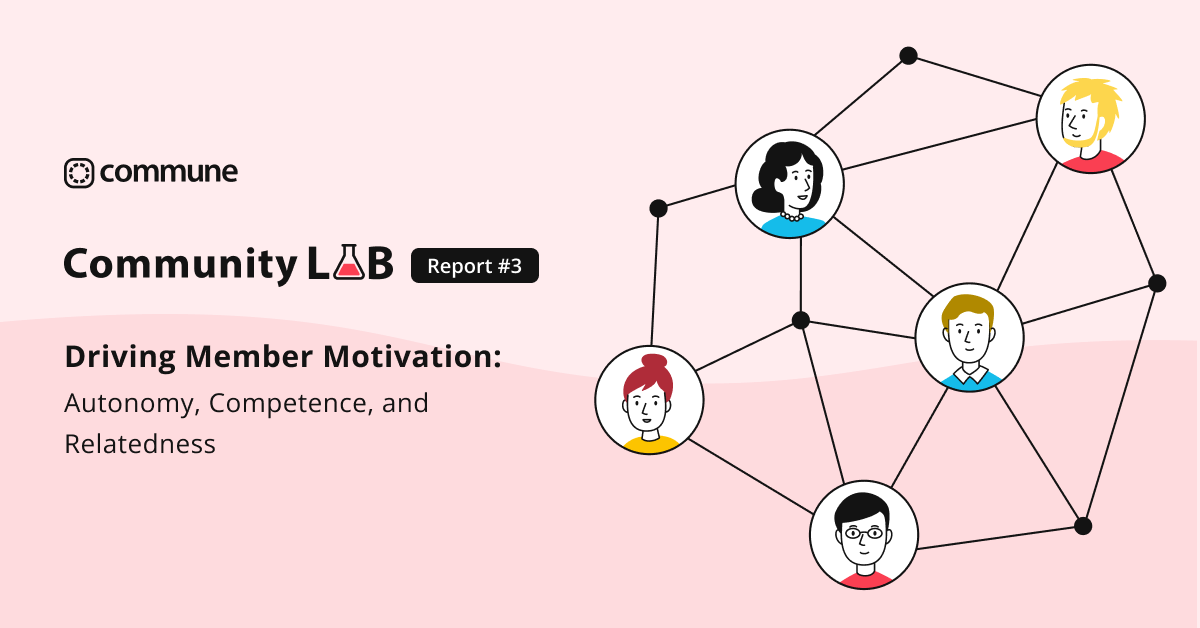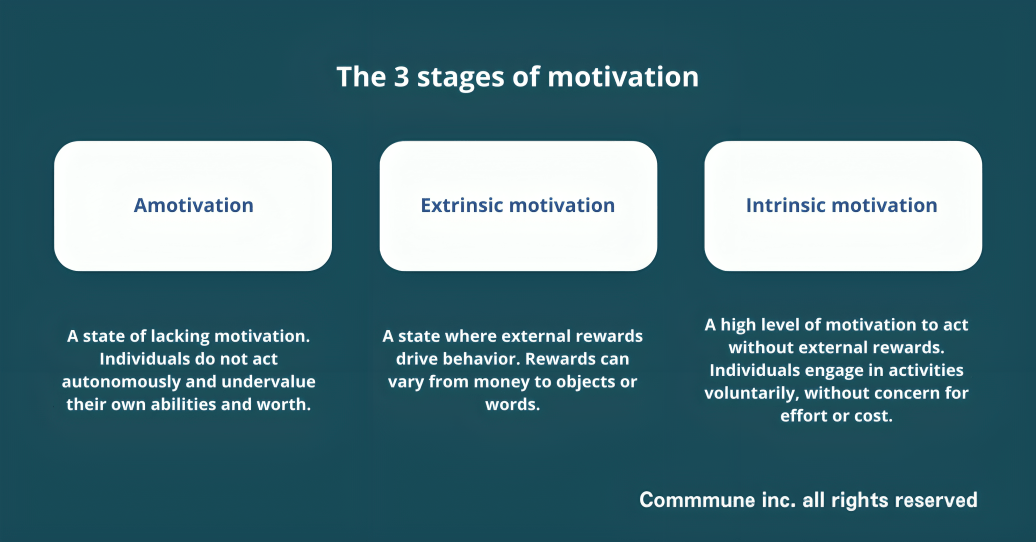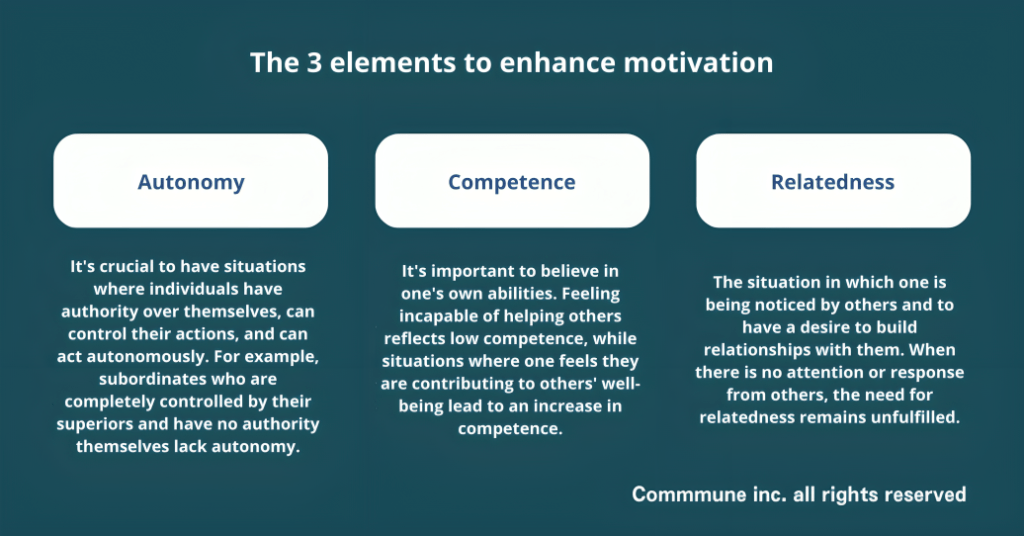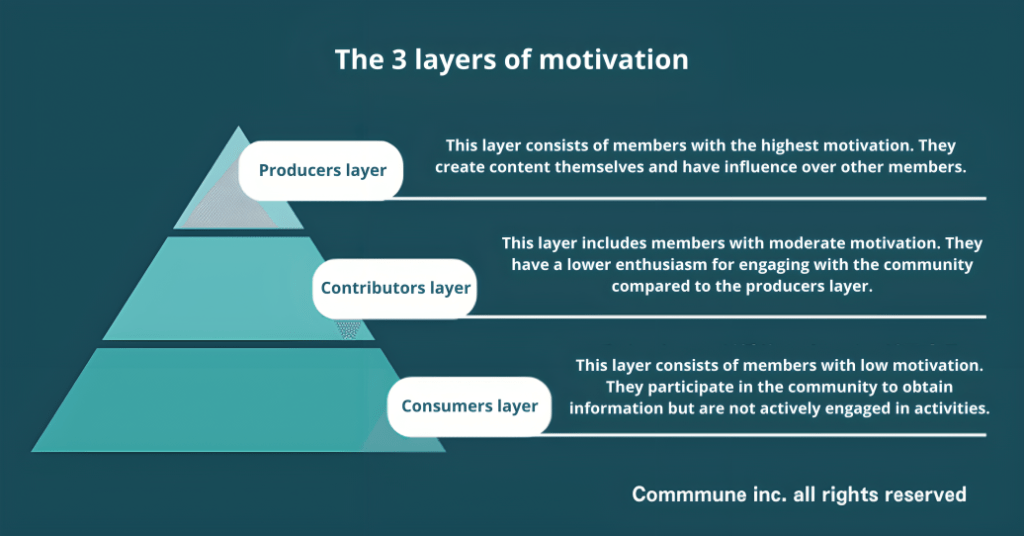
When members engage in activities within a community, some form of motivation is at play. It’s common in communities to see cases where members hesitate to take action even when the organizers directly reach out to them or take the lead. This might be due to a lack of motivation.
In this research, we aim to uncover elements that enhance motivation and suggest rules to increase active participation and excitement within the community.
This edition marks the third installment of research findings presented in this magazine. We hope you enjoy exploring what elements are necessary for members to become active and feel the excitement and potential of the community!
The foundation of this research is based on Self-Determination Theory (hereinafter, SDT). SDT, proposed by American psychologists Edward Deci and Richard Ryan in 1985, is a theory concerning motivation.
In SDT, motivation is broadly categorized into 3 stages:
In a community, it’s important to distinguish between members driven by extrinsic and intrinsic motivation. For the former, campaigns offering rewards can boost motivation, while for the latter, conveying messages that evoke excitement and empathy is more effective.
Furthermore, giving external rewards to individuals who are already intrinsically motivated can sometimes weaken their intrinsic motivation and lead them to act based on extrinsic motivation instead. This phenomenon is akin to extinguishing the joy of drawing that arises from within (intrinsic motivation) by providing external rewards (extrinsic motivation), as seen when giving money to a child who enjoys drawing. Eventually, the child may stop drawing if they no longer receive money.
From now on, we will explore when and how high intrinsic motivation arises.

In the aforementioned SDT, it’s proposed that high motivation driven by intrinsic motivation occurs when the following three psychological needs are fulfilled:
Now, the question arises: Do the relationships between these 3 psychological needs and high motivation also exist within communities? In other words, does SDT hold true in contemporary communities? To analyze this, let’s categorize community members into 3 layers.

To quantitatively analyze the community, it’s essential to classify its members. Let’s categorize members into 3 layers based on their actions within the community.
This layer consists of members with the highest motivation. They create content themselves and have influence over other members. In this analysis, members who ranked in the top 40% in terms of posts, the top 50% in terms of reactions received on posts, and the top 50% in terms of comments or reactions given were classified into this layer, aggregated on a monthly basis.
This layer includes members with moderate motivation. They may create content themselves but have a lower enthusiasm for engaging with the community compared to the producer’s layer. In this analysis, members who didn’t fit into either the producer’s or consumer’s layers, as described below, were classified into this layer.
This layer consists of members with low motivation. They participate in the community to obtain information but are not actively engaged in activities. In this analysis, members who had zero posts, ranked in the bottom 10% in terms of reactions received on posts, and ranked in the bottom 10% in terms of comments or reactions given were classified into this layer, aggregated on a monthly basis.
*The classification approach is subjective and various perspectives exist. This analysis serves as an experimental attempt to see the potential outcomes of such categorization.

Now, let’s get to the main topic. Are the 3 layers of motivation related to the 3 elements of psychological needs that enhance motivation?
To verify this hypothesis, it would be ideal to demonstrate that “members of the producers layer have all 3 elements (autonomy, competence, and relatedness) while members of the consumers layer lack some of these elements.”
Since it’s impossible to directly quantify psychological needs, quantitative and qualitative data are needed.
Fortunately, Commune conducts regular interviews with community members, and we utilized the text data from these interviews as qualitative data.
Upon extracting segments related to autonomy, competence, and relatedness from the interview transcripts, there was indeed a tendency for members of the producers layer to possess all 3 elements (autonomy, competence, and relatedness).
Now, let’s delve into the specific situations within the community that enhanced autonomy, competence, and relatedness. I will provide an abstract version because it contains sensitive information.
In communities, especially online communities, there are often no restrictions on posting or commenting from the outset, allowing for a certain level of autonomy. However, there can be psychological barriers when it comes to actually making a post. Overcoming these psychological barriers allows individuals to demonstrate autonomy and become active participants. For example, member “A” suddenly became active in a diet community. “A” began incorporating more vegetables into their meals, resulting in colorful and visually appealing photos attached to their posts. With improved photography skills, the psychological barrier to posting decreased, and A’s motivation increased to try new things. Quantitative data also showed a shift from the contributor’s layer to the producer’s layer.
Some members expressed joy when receiving positive reactions or comments on their posts. The perception that one is valuable and contributing to the community seems to increase competence. This, in turn, boosts motivation and activity levels. Quantitative data also showed shifts from the consumers layer to the contributors layer and from the contributors layer to the producers layer.
Among the 3 elements of motivation, relatedness appears to have a particularly significant impact. Qualitative data show that building relationships within the community leads to increased motivation, with quantitative data indicating subsequent increases in activity levels. These relationships particularly influence the transition from the contributors to the producers.
In this way, the 3 elements of psychological motivation were found to be important for the shift from the consumers layer to the contributor’s layer and from the contributors layer to the producer’s layer, but the reverse phenomenon was also confirmed. When shifting from the producers layer to the contributors layer or from the contributors layer to the consumers layer, one of the 3 elements tends to be lost. This highlights the need for ongoing efforts to maintain all 3 elements.
When dividing the motivation of members in the community into 3 layers of consumers, contributors, and producers, it was found that the shift between these layers occurs when the psychological needs of autonomy, competence, and relatedness are fulfilled. This aligns with the previously proposed Self-Determination Theory, indicating its relevance to modern online communities.
Among the 3 layers, the producer’s layer, where motivation is highest, plays a crucial role in elevating the community’s overall energy due to its influence on other users. Therefore, mechanisms and strategies for community management are required to facilitate shifts from the consumers layer to the contributors layer, and further from the contributors layer to the producers layer.
Previous research findings in “Energizing Community Growth: Insights from Commune’s Data-Driven Analysis” suggested that community managers are active in the early stages and contribute to the community’s growth by gradually transferring the role of the main player to other members. Community managers’ initial activity may help reduce psychological barriers for members, thus enhancing “autonomy.” Additionally, members may feel a sense of “competence” when receiving comments or reactions from community managers. Moreover, the consistent presence of community managers in the community may be perceived as “relatedness” by members.
Overall, it can be concluded that community managers must be particularly active in the early stages to enhance members’ motivation (through the 3 elements). Therefore, this study’s findings are consistent with previous ones, providing a coherent understanding of the role of community managers in enhancing member motivation.
By dividing community members into 3 layers, we can consider a “layered approach” based on the level of motivation. Assuming that the consumer’s layer represents a lack of motivation, the contributor’s layer represents extrinsic motivation, and the producer’s layer represents intrinsic motivation, we can provide external rewards to the contributor’s layer and appeal to emotions and empathy for the producer’s layer.
Furthermore, another research finding, titled “8 patterns of onboarding,” suggests that prioritizing activities that enhance autonomy, competence, and relatedness could enhance community management.
Through this research, we were able to increase our understanding of community members’ motivations. Everyone involved in communities should take a moment to examine their own communities from the perspective of motivation. You might discover new insights!
For those seeking to enhance their community managment processes, Commune’s strategic consulting service has successfully supported over 300 communities, from startups to established enterprises, in launching and managing their community initiatives. To learn more about how we can collaborate to enrich your community experience, book a demo today.